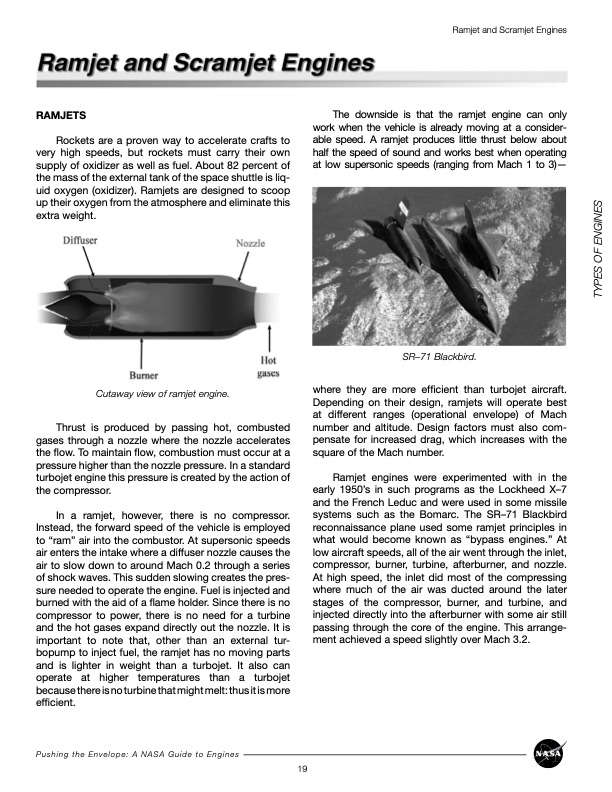
PDF Publication Title:
Text from PDF Page: 027
RAMJETS Rockets are a proven way to accelerate crafts to very high speeds, but rockets must carry their own supply of oxidizer as well as fuel. About 82 percent of the mass of the external tank of the space shuttle is liq- uid oxygen (oxidizer). Ramjets are designed to scoop up their oxygen from the atmosphere and eliminate this extra weight. The downside is that the ramjet engine can only work when the vehicle is already moving at a consider- able speed. A ramjet produces little thrust below about half the speed of sound and works best when operating at low supersonic speeds (ranging from Mach 1 to 3)— SR–71 Blackbird. where they are more efficient than turbojet aircraft. Depending on their design, ramjets will operate best at different ranges (operational envelope) of Mach number and altitude. Design factors must also com- pensate for increased drag, which increases with the square of the Mach number. Ramjet engines were experimented with in the early 1950’s in such programs as the Lockheed X–7 and the French Leduc and were used in some missile systems such as the Bomarc. The SR–71 Blackbird reconnaissance plane used some ramjet principles in what would become known as “bypass engines.” At low aircraft speeds, all of the air went through the inlet, compressor, burner, turbine, afterburner, and nozzle. At high speed, the inlet did most of the compressing where much of the air was ducted around the later stages of the compressor, burner, and turbine, and injected directly into the afterburner with some air still passing through the core of the engine. This arrange- ment achieved a speed slightly over Mach 3.2. Cutaway view of ramjet engine. Thrust is produced by passing hot, combusted gases through a nozzle where the nozzle accelerates the flow. To maintain flow, combustion must occur at a pressure higher than the nozzle pressure. In a standard turbojet engine this pressure is created by the action of the compressor. In a ramjet, however, there is no compressor. Instead, the forward speed of the vehicle is employed to “ram” air into the combustor. At supersonic speeds air enters the intake where a diffuser nozzle causes the air to slow down to around Mach 0.2 through a series of shock waves. This sudden slowing creates the pres- sure needed to operate the engine. Fuel is injected and burned with the aid of a flame holder. Since there is no compressor to power, there is no need for a turbine and the hot gases expand directly out the nozzle. It is important to note that, other than an external tur- bopump to inject fuel, the ramjet has no moving parts and is lighter in weight than a turbojet. It also can operate at higher temperatures than a turbojet because there is no turbine that might melt: thus it is more efficient. Ramjet and Scramjet Engines Pushing the Envelope: A NASA Guide to Engines 19 TYPES OF ENGINESPDF Image | NASA Guide to Engines

PDF Search Title:
NASA Guide to EnginesOriginal File Name Searched:
nasa-guide-to-engines.pdfDIY PDF Search: Google It | Yahoo | Bing
NFT (Non Fungible Token): Buy our tech, design, development or system NFT and become part of our tech NFT network... More Info
IT XR Project Redstone NFT Available for Sale: NFT for high tech turbine design with one part 3D printed counter-rotating energy turbine. Be part of the future with this NFT. Can be bought and sold but only one design NFT exists. Royalties go to the developer (Infinity) to keep enhancing design and applications... More Info
Infinity Turbine IT XR Project Redstone Design: NFT for sale... NFT for high tech turbine design with one part 3D printed counter-rotating energy turbine. Includes all rights to this turbine design, including license for Fluid Handling Block I and II for the turbine assembly and housing. The NFT includes the blueprints (cad/cam), revenue streams, and all future development of the IT XR Project Redstone... More Info
Infinity Turbine ROT Radial Outflow Turbine 24 Design and Worldwide Rights: NFT for sale... NFT for the ROT 24 energy turbine. Be part of the future with this NFT. This design can be bought and sold but only one design NFT exists. You may manufacture the unit, or get the revenues from its sale from Infinity Turbine. Royalties go to the developer (Infinity) to keep enhancing design and applications... More Info
Infinity Supercritical CO2 10 Liter Extractor Design and Worldwide Rights: The Infinity Supercritical 10L CO2 extractor is for botanical oil extraction, which is rich in terpenes and can produce shelf ready full spectrum oil. With over 5 years of development, this industry leader mature extractor machine has been sold since 2015 and is part of many profitable businesses. The process can also be used for electrowinning, e-waste recycling, and lithium battery recycling, gold mining electronic wastes, precious metals. CO2 can also be used in a reverse fuel cell with nafion to make a gas-to-liquids fuel, such as methanol, ethanol and butanol or ethylene. Supercritical CO2 has also been used for treating nafion to make it more effective catalyst. This NFT is for the purchase of worldwide rights which includes the design. More Info
NFT (Non Fungible Token): Buy our tech, design, development or system NFT and become part of our tech NFT network... More Info
Infinity Turbine Products: Special for this month, any plans are $10,000 for complete Cad/Cam blueprints. License is for one build. Try before you buy a production license. May pay by Bitcoin or other Crypto. Products Page... More Info
| CONTACT TEL: 608-238-6001 Email: greg@infinityturbine.com | RSS | AMP |